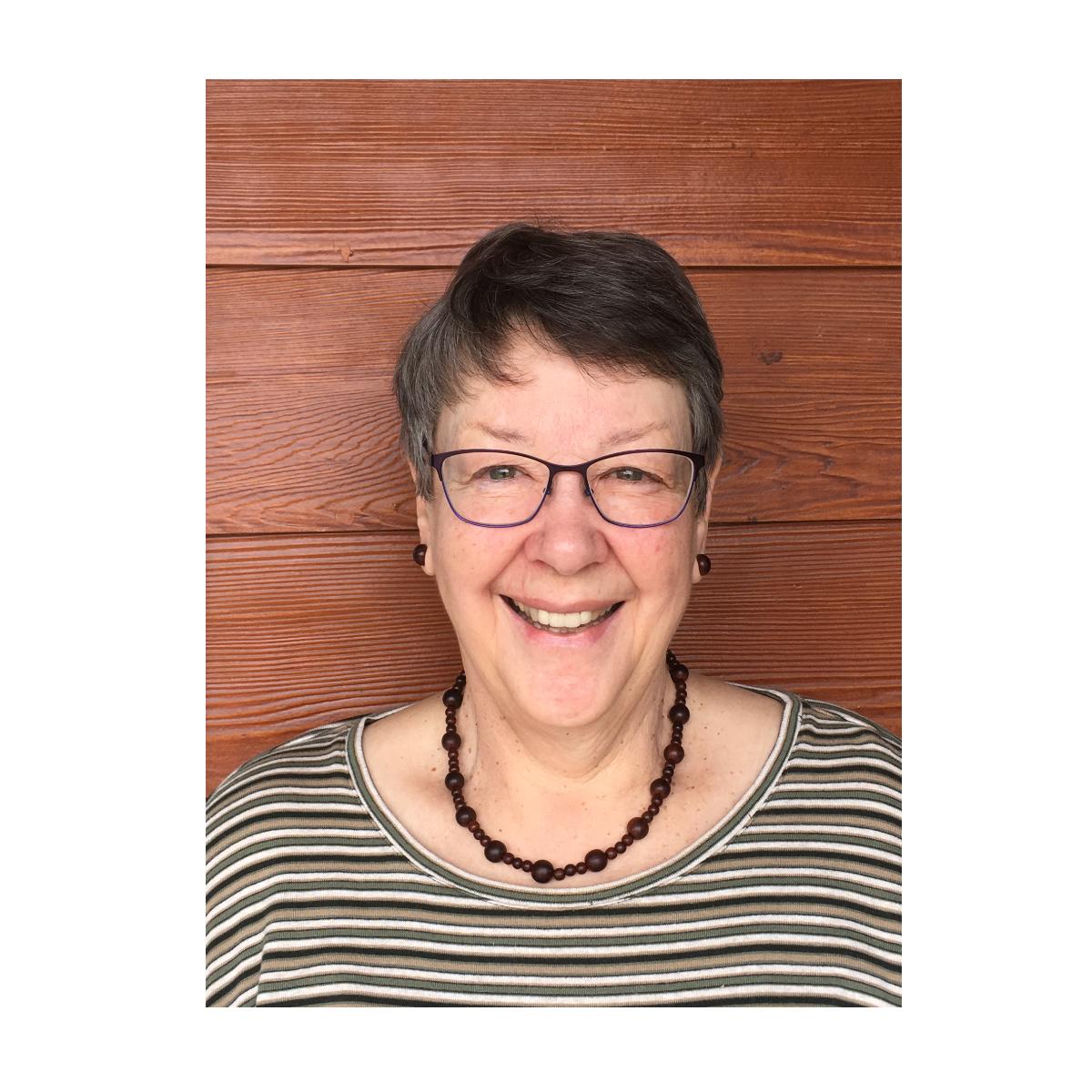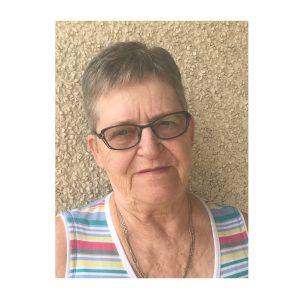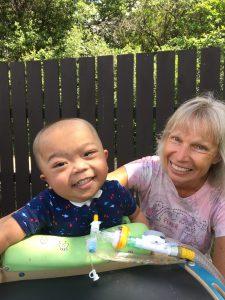Gail Bissett is a passionate person; she’s one of those people who laughs loudly, has many interests, is positive and upbeat, and is very engaging. She has travelled extensively, has reached her goal of visiting every continent on Earth, including Antarctica. As we visit over her dining room table it’s quickly evident what one of her biggest passions is: death.
At 73, she’s become well acquainted with it. She knows how arbitrary it is, how unexpected it often is, how paramount an event it is. She knows there are myriad aspects to it; some explainable with science, and some not. What she doesn’t understand is why we don’t talk about it more. “It’s become my mission now to promote discussions on death and dying,” she states, her eyes bright with enthusiasm.
Gail’s career was in nursing; she practiced at Royal University Hospital, she taught nursing at SIAST (then Kelsey Institute), she conducted tuberculosis clinics in the north. So she was not completely out of her depth when her husband John had a heart attack in 1996. But with only 25 per cent use of his heart left, he needed a transplant. At that time, the closest place to have such a surgery was London, Ontario, and the couple flew there on several occasions for assessments. Desperately needing a transplant, but not knowing if and when it would ever happen put a huge strain on their lives. “I had PTSD throughout the whole process of him needing a transplant,” says Gail, “but nobody talked to partners and families about this at that time; they didn’t help. I identified it myself later when I was doing lots of reading, they talked about it in the Heartmates book.”
There were all sorts of other potential experiences not talked about back then, too – ones that a person dying may have as they got closer to the end. “There was one day John got this feeling, he told me about it the next morning. He said he’d had a near death experience. He couldn’t feel his heart beating any longer, and he was going down a tunnel, there was a light at the end of it. He said it was the most peaceful experience … but he hadn’t said ‘goodbye’ to me yet, so he managed to turn himself around and come to. I don’t know how he had the presence of mind to do that.”
Gail knows now, through her extensive reading and training on the subject of dying, that near death experiences or NDEs are experienced by between 4 and 15 per cent of the general population. According to the International Association for Near Death Studies (IANDS):
More than 15 common characteristics of an NDE have been reported by near death experiencers. An NDE may include only one or two of these elements, and, in a few cases, all of them. These include: a sense of being outside one’s physical body, sometimes perceiving it from an outside position; a sense of movement through darkness or a tunnel; intense emotions; heightened perceptions; experiencing a great light or darkness; perceiving a spiritual realm, which may include vividly memorable landscapes; encounters with deceased loved ones, spiritual beings and/or religious figures; knowledge of the nature of the universe; a life review; a sense of oneness and interconnectedness; a border of no return; a sense of having knowledge of the future; messages regarding life’s purpose.
Sadly, John did not get his heart transplant in time; he died in 2000 at the age of 53. Gail credits the presence of their two daughters for helping her move through the pain and the loss. “Having the girls around forced me to deal with my grief,” she states. “I wanted to be a role model for them. I’m a practical, realistic person; stuff happens. This is the way life is – I either make it or I don’t. But I have choices.” She chose to face her new reality head-on.
“After John died, I got so interested in learning more about death and dying. I read all sorts of books about it and thought, ‘We know NONE of this!’ We aren’t taught about death and dying, we don’t discuss it in our culture. When people used to die in their own homes, that was part of family life – but we don’t see that anymore. Have you read Final Gifts?”
Gail jumps up from her chair, and returns from the bedroom moments later with her arms full of books. She lays them on the table, then picks out Final Gifts: Understanding the Special Awareness, Needs, and Communications of the Dying, and starts flipping it open to the flagged pages. “This book should be pre-reading before anybody dies,” she says. “It’s written by two hospice nurses, there’s so much good information in here.” She finds the page she’s looking for, then reads aloud:
Unlike earlier generations, they [we] don’t learn how to be at ease with someone whose life is coming to an end. Illness and death have been moved out of the house and into the hospital or nursing home. Professionals provide the care; relatives and friends become spectators watching something occur—not in a continuous stream of emotions and experiences from which to learn, but in awkward chunks of time, determined by official visiting hours that leave them uncomfortable and unsatisfied.
“Death should be part of our everyday conversation,” says Gail, “but we are afraid. People say it’s so morbid to talk about, but it’s all going to happen to us!” Gail rifles through the other books on the table. Another book she’s passionate about is Healing After Loss. “This one is an absolute necessity, it’s very succinct and it keeps you in reality. I’ve given this to so many people who’ve lost a spouse, because people tend to go into denial. Proof of Heaven, that one is excellent. Being Mortal is really interesting … A Good Death is great!”
Gail had the opportunity to put all her reading into action when her neighbour was dying of breast cancer. “When the palliative care people came to her suite, I’d be with her. I was her support, her second pair of ears, because when people are that sick they cannot take in all the information coming at them. I was basically with her the night she called the ambulance and went to St. Paul’s, where she died. Her son went with her, but her daughter-in-law and grandchild stayed behind. We got talking about death and dying, what to expect … the steps that a dying person goes through.”
As a person is actively dying, there are notable changes: in their skin colour and temperature; in their breathing; in their appetite and thirst levels. As well, it is not uncommon for people to have visions, or to know exactly when their death will occur. This is known as Near Death Awareness (NDA), and it is now becoming better documented by medical professionals. According to the Foundation for Near-Death Studies:
Nearing-death awareness (NDA) involves a dying person who describes a dimension that seems to be beyond the world as we know it, often in symbolic terms. The dying person may appear to be talking to dead relatives or friends, speak of getting ready to travel or prepare for a big occasion, and describe an unearthly realm. Unfortunately, if the caregiver is not listening carefully, these discussions are interpreted as hallucinations or delirium by the dying person. NDAs are associated with a sense of peace and joy for the dying person and many consider it a gift to those left behind.
“When patients present as confused, we don’t realize it’s part of the dying process,” says Gail. “In the hospital my neighbour thought she was going on a road trip. Or she would say that there was a whole roomful of people even though there’d be one or two. It’s important not to contradict or deny their experience. They’re on a different plane than we are, we can’t understand where they’re at. When my mother was dying in the hospital she said, ‘I can see Jesus there, and I can see my brother Glen (who had died previously), but I can’t get there yet.’
“Who are we to say they’re not seeing those people? There are just too many of these near death experience stories and anecdotes at the end of life to dismiss. Science does not know everything. These NDEs are very, very real.”
In 2014, Gail took her training to be a volunteer with the Prairie Hospice Society (PHS). For the first year and a half, she was a companion to a woman in her 90s. “She was the most beautiful woman,” smiles Gail. “The most giving, accepting, positive person. Often I would come away feeling better than when I’d went in. She was just that inspiring, just that warm.” The two would play games, converse, colour in colouring books together. “On nice days, we went out for wheelchair walks.” Gail happened to be at her client’s bedside – providing a brief respite for a family member – when her client died. “I was holding her hand, to provide comfort, and I was talking to her,” says Gail. “I said, ‘If you’re ready to go, it’s okay.’ It’s important to give permission, to give your blessing to people so they know they can leave. She and I had a really good relationship, I think she was comfortable going with me there.” Gail considers herself very privileged to be with her friend through her death. After the woman died, Gail took a several-month break from volunteering with PHS to process the experience.
She then spent the next three and a half years volunteering with Hospice Now, a program of PHS. This initiative isn’t about providing a companion to come in every week to visit or help the client; Hospice Now helps clients with more immediate and sporadic needs, by giving them rides to and from medical appointments – say, the Cancer Clinic for chemotherapy or radiation sessions – or walking their dog because they’ve suddenly gone into hospital. “There are no preliminary introductions, no small talk, no pretenses,” says Gail. “You’re meeting this person exactly where they are in their life right now.” And this suited Gail well. “I absolutely loved that,” she says. “You’re meeting all kinds of clients in all circumstances. I’m a social person,” she adds, “so to have that variety of clients really fed into me and I could feed into them too.”
Gail was a regular driver for Marilyn Zorn and her husband David, who was dying of cancer. “Marilyn and I were so in touch, we were so in tune,” says Gail. In fact, when David was in a palliative state at St. Paul’s Hospital, Marilyn was one day in need of a ride downtown to her long-awaited appointment with a cardiologist. “We were just coming out from the office when Marilyn got the phone call from her sister-in-law that she needed to come to St. Paul’s immediately,” says Gail. “We drove to the hospital, but David had just passed. I asked if she’d like me to come up to the room with her and she said that would be fine – it was just Marilyn and her sister-in-law and me.” Gail said she basically stayed in the background, gave Marilyn some hugs, put her hand on her shoulder. After an hour or so, they collected David’s belongings, and Gail drove the women home. “I said to them, ‘Ask me anything you want, let me know if I can help in any way.’” Gail assisted Marilyn in the aftermath of David’s death too, driving her to see a lawyer to deal with his will, helping pick up floral arrangements for his funeral.
“Hospice clients are so welcoming to let you come into their lives,” says Gail. “You’re instant family. They accept you right in, it’s very special. They support us as much as we support them – they’re so appreciative of the rides and the conversations … the sharing of experience.”
Gail has been to three or four funerals of PHS clients she had gotten to know through Hospice Now. “There was a Bangladeshi family whose 10-year-old boy was diagnosed with cancer. The mother didn’t drive, so I would take her to the hospital. One time it was his birthday, and so I bought a cake for her to take up to him. When she called me to be picked up, she asked me to come up to the room and have cake with them. It was so important, to make that connection. I went to the Prayer Service when the boy died, the dad didn’t know I was coming and he was so ecstatic – he hugged me. It was so beautiful, there were children there and adults, we all dropped flower petals around the boy as he lay in a casket. The Filipino community too – their funerals are so warm, and open, and compassionate. This has been such a blessing for me to experience different cultures and to see what we’re lacking in our own.
“In our culture, we shelter kids from the idea of death … well, they think they’re immortal anyway,” she quips. “But kids in high school could start learning about this. I think it’s as important as Sex Ed. Take the whole topic of LGBTQ [Lesbian Gay Bisexual Transgender Queer or Questioning]; it’s now so forefront. Death should be the same, we should make it a comfortable conversation to talk about. Bring it out of the closet!” she laughs, pleased with the irony.
Gail does see the general public becoming more receptive to exploring some of the issues surrounding death, thankfully. This is aided by recent phenomena such as Death Cafes, now being held in many larger cities, including Saskatoon. “I’ve been to two Death Cafes,” says Gail. “It’s an opportunity to talk about death in a safe setting as opposed to ‘This is something we don’t discuss.’ It’s a support group where people can talk about absolutely anything, because we are all having common feelings, common thoughts.”
As well, she likes that the traditional sombre funerals are giving way to Celebrations of Life. “We relish in the joy of a birth, why can’t we relish in the joy of a death? This person lived a life, why can’t we celebrate what they did, what they accomplished, who they were. Let’s celebrate the life they had!”
While Gail is taking a break from being on call as a Hospice Now driver, she is still willing to do vigil work with PHS. This is requested when a person actively dying has no family able to be present at the moment. “We’re kind of a fill-in, a person available to be with them, so that they’re not alone.” One of the people she sat vigil for was an elderly nun. Gail was always saddened that no one thought to bring her little dog in to see her at the end – both for the sake of the woman, and her dog. “When John was dying,” says Gail, “we brought our big lab Mishka up to his hospital room. It was Christmas Day, and John was unconscious after his heart attack. Mishka had been very antsy with John not being home, he’d always travelled with John. Mishka got his front paws up on the bed, sniffed around John’s neck twice, and then he was settled. Pets have to be treated as part of the family, they need to know what’s happened to their loved one too.”
Another facet of death that people need to talk more about is estate planning, says Gail. Besides being the executrix of John’s estate, she was left to handle the details of his parents’ estate, as well as oversee her own parents’ wills. “I was not taught how to get through all of this,” says Gail. “I don’t think anybody appreciates what it involves – people do not realize how much work it entails to be the executor of an estate.” She recommends the Just In Case binders, written in Saskatoon by Harold Empey, as the homework everyone should complete in preparation for their eventual death. “Then your executor can just open up the binder and walk right through the process,” she says matter-of-factly. “Because when a loved one dies suddenly or traumatically, the family are unable to process, they’re in shock, they’re devastated, they can’t think. People don’t realize it but making these arrangements ahead of time, discussing it with your executors and family members – this is crucial.
“I’ve got my obituary written, my funeral plans, all the contact numbers my daughters will need, all the details of my financial stuff … credit card numbers to be cancelled. The best gift you can ever give another family member is to have all these details already written out, to be prepared for your death.” And she smiles, self-satisfied.
* * *
John had been a man who was happiest in the mountains and the wilderness. “He was a hunter, of both birds and animals,” says Gail, “he had a real respect for them. He always loved wildlife,” she reflects, “and so do I.” One day, as they were waiting for John’s heart transplant, the couple was walking by the river in Saskatoon, admiring all the geese out on the sandbars. John wondered aloud if he’d ever see those amazing flocks in flight again. “Now,” Gail smiles, “when the geese fly by, I always think it’s John saying ‘Hi’ to me. He’s in the animal/bird spirit world somewhere, that’s how I choose to interpret it. And that’s our connection still – through wildlife.
“You have to have an open mind, even if you don’t believe,” says Gail. “These are possibilities beyond our realm of understanding.” And she flips to a page from Proof of Heaven: A Neurosurgeon’s Journey Into the Afterlife, then reads aloud:
We can only see what our brain’s filter allows through. The brain—in particular its left-side linguistic/logical part, that which generates our sense of rationality and the feeling of being a sharply defined ego or self—is a barrier to our higher knowledge and experience.
Closing the book, Gail marvels: “What happens after we die? This may well remain one of the big mysteries of life!” Her eyes dance with delight at the possibilities. For now, however, Gail has another passion that she needs to attend to: an upcoming river cruise on the culture-rich Danube which she must pack for.
“One’s destination is never a place, but a new way of seeing things.” Henry Miller
(Jacquie Moore is a Saskatoon writer. She has been a volunteer companion with the Prairie Hospice Society since 2014.)




